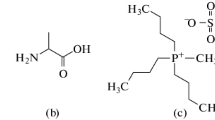Summary
The gelation of-aqueous gelatin solutions is caused by crystallization of the polymer component. Investigations of the melting curve in this system lead to the conclusion, that during isothermal formation of microcrystals under certain conditions only metastable states can be reached. Theoretical considerations, which are analogous to the approach of Hoffman and Weeks for pure polymers, show, that the melting temperature will be a linear function of the crystallization temperature also in solutions. Experimentally it is found, that this condition holds. Therefore the equilibrium melting point in true binary systems may be obtained by extrapolation.
By means of the equilibrium melting points at different and constant compositions the state diagram of gelatin-water is constructed in nearly the whole concentration range. The thermodynamic quantities like the melting point and enthalpy of fusion of pure gelatin and the interaction parameter agree well with data from the literature. Osmotic measurements in this system using the same gelatin show that temperature and concentration dependence of the interaction parameter may be neglected.
The discussion of the linear relationship between melting and crystallization temperature reveals for the system gelatin-water, that a quantitative description is only possible in the very dilute range.
Zusammenfassung
Die Gelbildung wäßriger Gelatinelösungen wird durch die Kristallisation der polymeren Komponente verursacht. Untersuchungen der Schmelzkurve im System Gelatine —Wasser führen zu dem Ergebnis, daß unter bestimmten experimentellen Bedingungen bei der isothermen Kristallisation nur metastabile Zustände entstehen. Theoretische Betrachtungen, die an einen Ansatz vonHoffman undWeeks für reine Polymere angelehnt sind, zeigen, daß auch in Lösungen die Schmelztemperatur linear von der Kristallisationstemperatur abhängig ist. Experimentell wird dieser Zusammenhang bestätigt. Daher kann auch in reinen binären Systemen der Gleichgewichtsschmelzpunkt durch eine Extrapolation bestimmt werden.
Mit Hilfe der Gleichgewichtsschmelzpunkte, die bei verschiedenen konstanten Zusammensetzungen ermittelt wurden, konnte das Zustandsdiagramm des Systems Gelatine - Wasser nahezu im gesamten Konzentrationsbereich bestimmt werden. Die daraus erhaltenen thermodynamischen Größen wie die Schmelztemperatur und Schmelzwärme der reinen Gelatine und der Wechselwirkungsparameter stimmen gut mit Literaturwerten überein. Osmotische Messungen in diesem System mit der gleichen Gelatine zeigen, daß die Abhängigkeit des Wechselwirkungsparameters von Temperatur und Konzentration vernachlässigbar klein ist.
Die Diskussion der linearen Beziehung zwischen Schmelz- und Kristallisationstemperatur ergibt, daß eine quantitative Beschreibung nur im Bereich der verdünnten Lösungen möglich ist.
Similar content being viewed by others
Literature
Tomka, L., J. Bohonek, A. Spühler, M. Ribeau J. Photograpic Sci,23, 97 (1975).
Flory, P. J., E. S. Weaver, J. Amer, Chem. Soc.82, 4518 (1960).
Petrie, S. E. B., R. Becker, Analytical Calorimetry 2.
Mandelkern, L., Crystallization of Polymers (New York 1974).
Borchard, W, K. Bergmann, A. Emberger, G. Behage, Progr. Colloid & Polymer Sci.60, 120 (1976).
Borchard, W., K. Bergmann, G. Rehage, in: Photographic Gelatin II, p. 60, ed byR. J. Cox, Academic Press (London 1976).
Hoffman, J. D., J. J. Weeks, J. Res. Nat. Bur. Stds.66A, 13 (1962).
Bremer, W., Diplomarbeit (Clausthal 1977).
Girolamo, M., A. Keller, M. Miyasaka, N. Overbergh, J. Polymer Sci. A-2,14, 39 (1976).
Price, C., P. A. Harris, T J. Holton, Polymer16, 69 (1965).
Hoffman, J. D., J. I. Lauritzen, J. Res. Nat. Bur. Stds.65A, 4 (1961).
Flory, P. J., J. Chem. Phys.10, 51 (1942).
Huggins, M. L., Ann. N. Y. Acad. Sci43, 1 (1942).
Flory, P. J., Principles of Polymer Chemistry, Cornell University Press, Ithaca, N. Y. (1953).
Thomson, W., Phil. Mag.42, 948 (1881).
Thurnbull, D., J. C. Fischer, J. Chem. Phys.17, 71 (1949).
Godard, P., J. J. Biebuyck, M. Daumerie, H. Naveau, J. P. Mercier, Polymer Sci., Chem. Ed.16, 1817 (1978).
Keese, A., Diplomarbeit (Clausthal 1978).
Yuan, L., A. Veis: Biophys. Chem.1, 117 (1973).
Knoche, W., M. P. I. forBiophys. Chemistry, Göttingen (private communication).
Asbach, G.-L., Dissertation (Ulm 1972).
Kilian, H. G., G. I. Asbach (private communication).
Lemstra, P. J., T. Kooistra, G. Challa, J. Polym. Sci. Part A-2,10, 823 (1972).
Wunderlich, B., in: Macromolecular Physics, Vol. II, Chap. 7, Academic Press (1973).
Jolley, J. E., Photogr. Set. Eng.14, 169 (1970).
Hirai, H., Bulletin of the Inst. for Chem. Res., Kyoto33, 21 (1955).
Smith, K. J., A. Greene, A. Ciferri, Kolloid-Z. and Z. Polymere194, 49 (1964).
Bianchi, E., G. Conio, A. Cifferi, D. Puett, L. Rajagh, J. Biol. Chem.242, 1361 (1967).
Grant, R. A., R. W. Horne, R. W. Cox, Nature207, 822 (1965).
Mandelkern, L., J. Appl. Phys.26, 443 (1955).
Hermanns, B., Diplomarbeit (Clausthal 1970).
Pouradier, J., A. M. Venet, J. Chim. Phys.49, 239 (1952).
Borchard, W., A. Keese, IUPAC Symposium, Vol. 11, p. 888 (Mainz 1979).
Kilian, H. G., Makromol. Chem.116, 219 (1968).
Walton, A. G., J. Blackwell, Biopolymers, p. 421, Academic Press, (New York 1973).
Privalov, P. L., E. J. Tiktopulo, Biopolymers9, 127 (1970).
Flory, P. J., R. R. Garret, J. Amer. Chem. Soc.80, 4836 (1958).
Author information
Authors and Affiliations
Additional information
Dedicated to Prof. Dr. G. Rehage on the occasion of his 60th birthday.
With 7 figures
Rights and permissions
About this article
Cite this article
Borchard, W., Bremer, W. & Keese, A. The state diagram of the water-gelatin system. Colloid & Polymer Sci 258, 516–526 (1980). https://doi.org/10.1007/BF01404159
Received:
Issue Date:
DOI: https://doi.org/10.1007/BF01404159




